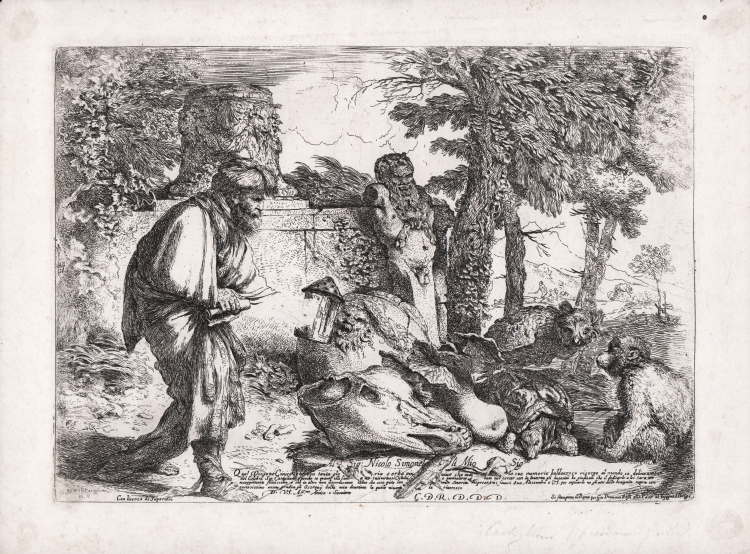




| Reference: | S43970 |
| Author | Giovanni Benedetto CASTIGLIONE detto "Il Grechetto" |
| Year: | 1645 ca. |
| Measures: | 302 x 220 mm |



| Reference: | S43970 |
| Author | Giovanni Benedetto CASTIGLIONE detto "Il Grechetto" |
| Year: | 1645 ca. |
| Measures: | 302 x 220 mm |
Diogenes in Search of an Honest Man, 1645-1647 etching, signed in plate lower left G. Beneds. Castiglionus in P. Inscription in lower right: Si stampano in Roma per Gio. Domenico Rossi alla Pace e al Insegna d Parigi.
Example in the second state of two, with the dedication to Nicolò Simonelli Mantova in the centre.
In a landscape full of light, Diogenes of Sinope is represented with a lit lantern in his hand, the glow of which 'devours' his forearm. The absence of this detail has been interpreted by many scholars as an indication of incompleteness of the plate, but, in reality, it can be read as a precise intention of the artist, who had wanted to emphasise the intensity of the light as a symbol of truth.
In the background is a forest in which there are elements reminiscent of ancient civilisation but also of its decadence. The exhibits include a carved altar representing pagan religion, a stele depicting Priapus, a symbol of male sexuality, a wineskin alluding instead to the female world, and a horse skull, a reference to death as the end of an illusory life. These objects are surrounded by vegetation and nature seems to have taken over from them. The scene is also enriched by the presence of some living animals, symbols of vanitas and the negative aspects of man. According to Cesare Ripa's Iconology, the owl, which is a nocturnal bird of prey, represents superstition, the monkey the imitation of the worst traits of man and the turtle sloth. In the background is a pastoral landscape.
The figure of Diogenes refers to the philosophical concept of the search for the honest man full of virtue, in allusion to the qualities of the character to whom the engraving is dedicated, namely Nicolo Simonelli. The latter was an attendant of the Pamphili family and distinguished himself as a sought-after collector, as well as a lover of philosophy. Among his favourite artists were Gian Lorenzo Bemini, Salvator Rosa, Pietro Testa and Pier Francesco Mola. To support his collecting passion, which was particularly directed towards drawings, he also engaged in the art trade.
The dedication, which only appears in the second state, was added by the printer Giovanni Domenico De Rossi. The etching is based on a drawing in the Windsor Castle collections and was executed in the years 1645-1647 in Genoa, as can be deduced from the absence of the appellation 'genuensis', which appears instead in plates engraved by Grechetto outside his home town. This invention inspired Salvator Rosa in the painting Democrite in meditation (Copenaghen. Statens Museurn for Kunst). In his engravings, Grechetto was influenced by Rembrandt, whose prints began circulating in Italy in the years before Diogenes was executed. From the Dutch master, the painter from Genoa borrowed the use of chiaroscuro and his predilection for striking luministic effects. His activity as an engraver was very intense: during his career, the artist devised more than sixty compositions to be translated onto the plate, favouring a fluid and pulsating stroke in order to create highly pictorial results.
Beautiful proof, printed on contemporary laid paper without watermark, with margins, in excellent condition.
Bibliografia
Bartsch / Le Peintre graveur (XXI.20.21); Bellini 1982 / L'Opera incisa di Giovanni Benedetto Castiglione (16.II).
Giovanni Benedetto CASTIGLIONE detto "Il Grechetto" (Genova 1616 - Mantova 1670)
|
His origin and his edication in Genua led Castiglione to make acquaitance with the Flemish painting, especially through Jaan Roos e Van Dyck from whom he took the warm, vibrating chromatism.
He lived in Rome from 1632 to 1635 and from 1647 to 1651; among the two periods in Rome, he lived in Naples and he also started studying the intellectualistic classicism of Poussin.
His favourite subjects, both in painting and engraving, were taken from the classical moralism of Stoicism, very typical in Poussin, which enabled him to create his own peculiar repertoire, much more refined in comparison with contemporary artists.
He spent his last working years in Mantua, at the Duke’s Palace; the production of this period enhances his chromatism and the visionary elements of his previous production.
Castiglione has been a silful engraver; he loved this particular art for he thought it was the main mean to widespread his iconography. He was the first, in Italy, to appreciate and imitate Rembrandt.
|
Giovanni Benedetto CASTIGLIONE detto "Il Grechetto" (Genova 1616 - Mantova 1670)
|
His origin and his edication in Genua led Castiglione to make acquaitance with the Flemish painting, especially through Jaan Roos e Van Dyck from whom he took the warm, vibrating chromatism.
He lived in Rome from 1632 to 1635 and from 1647 to 1651; among the two periods in Rome, he lived in Naples and he also started studying the intellectualistic classicism of Poussin.
His favourite subjects, both in painting and engraving, were taken from the classical moralism of Stoicism, very typical in Poussin, which enabled him to create his own peculiar repertoire, much more refined in comparison with contemporary artists.
He spent his last working years in Mantua, at the Duke’s Palace; the production of this period enhances his chromatism and the visionary elements of his previous production.
Castiglione has been a silful engraver; he loved this particular art for he thought it was the main mean to widespread his iconography. He was the first, in Italy, to appreciate and imitate Rembrandt.
|